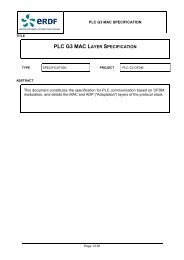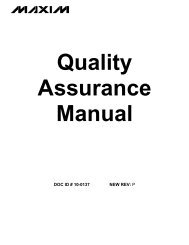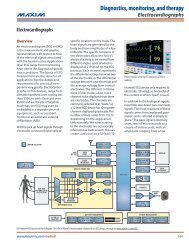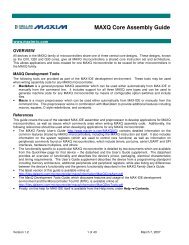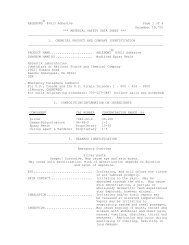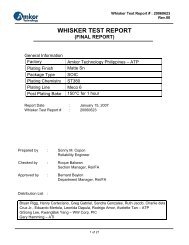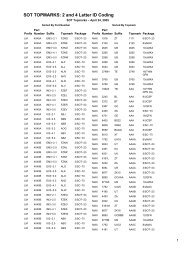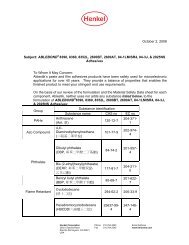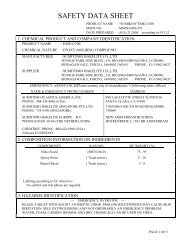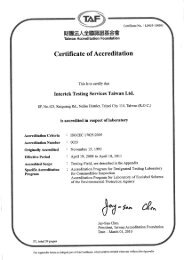MAXIM High-Speed Bipolar and BiCMOS Process Reliability Report
MAXIM High-Speed Bipolar and BiCMOS Process Reliability Report
MAXIM High-Speed Bipolar and BiCMOS Process Reliability Report
Create successful ePaper yourself
Turn your PDF publications into a flip-book with our unique Google optimized e-Paper software.
RR-B3A<br />
Finished wafers are inspected optically to detect any physical defects. They are then parametrically<br />
tested to ensure full conformity to Maxim's specifications. Our parametric measurement system is<br />
designed to make the precision measurements that will ensure reliability <strong>and</strong> reproducibility in integrated<br />
circuits.<br />
We believe our quality-control technology is the best in the industry, capable of resolving current levels<br />
below 1pA, <strong>and</strong> of producing less than 1pF capacitance. Maxim's proprietary software allows automatic<br />
measurement of subthreshold characteristics, fast surface-state density, noise, <strong>and</strong> other parameters<br />
crucial to predicting long-term stability <strong>and</strong> reliability. Every Maxim wafer is subject to this rigorous<br />
screening at no premium to our customers<br />
Statistical <strong>Process</strong> Control<br />
<strong>Reliability</strong> testing offes value only if the manufacturing process is kept "in control" statististically. Major<br />
process variation or process shift can invalidate reliability test results, leading to incorrect conclusions<br />
<strong>and</strong> diminishing the integrity of failure rate estimates.<br />
Maxim monitors the stability of critical process parameters through computerized Statistical <strong>Process</strong><br />
Control (SPC). Over 125 charts are monitored in-line during wafer production. These charts provide our<br />
engineers with immediate feedback on process trends <strong>and</strong> thus let engineers to take immediate action if<br />
needed to keep the process under control. Additionally, over 100 process parameters are monitored at<br />
Wafer Acceptance. Maxim has a Capability Coefficient (Cpk) goal of 1.3, which makes the electrical <strong>and</strong><br />
reliability performance of Maxim’s products be well at target with very little variation.<br />
In addition to SPC, Maxim uses Design of Experiments (DOE) to improve process capability, optimize<br />
process targeting, <strong>and</strong> increase process robustness.<br />
<strong>Reliability</strong> Testing<br />
Infant Mortality Evaluation ( IME )<br />
Maxim evaluates the infant mortality of all processes on an ongoing basis. Through the Infant Mortality<br />
analysis, the common defects for each process can be identified. Corrective action then will be taken to<br />
correct or optimize the manufactuing process , thus to improve reliability. For an illustration of Maxim/s<br />
low Infant Mortality rate, refer to Table 3.<br />
HTOL ( <strong>High</strong> Temperature Operational Life ) Test<br />
Life Test is performed using biased conditions that simulate a real-world application. This test estimates<br />
the product's field performance over a long time period. It establishes the constant failure-rate level ( in<br />
FIT ) <strong>and</strong> identifies any early wearout mechanism. The device under test is operated at a controlled,<br />
elevated ambient temperature to ensure device junctions are at +150 °C. This test can detect design,<br />
manufacturing, silicon contamination, metal integrity, <strong>and</strong> assembly-related faults.<br />
HTOL Test<br />
Test Conditions: 150°C operating junction temperature, 1000 hrs, Static bias, 100% duty<br />
cycle<br />
Failure Criteria:<br />
Must meet data sheet specifications<br />
Results: See Table 1 <strong>and</strong> table 4 - 11<br />
Page 6 of 30




